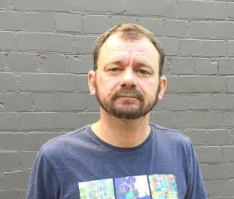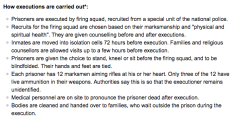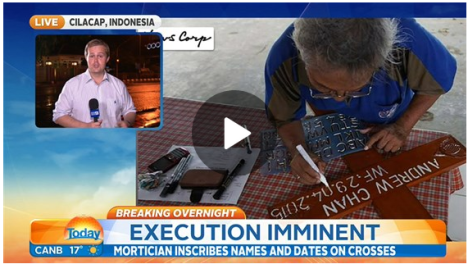Media has no need to dramatise an event that is already fuelled with drama
 Distressing images of coffins being delivered to an Indonesian prison, crosses being made and details of the execution process for nine drug smugglers awaiting the firing squad are gratuitous and tasteless, argues Mumbrella’s Steve Jones.
Distressing images of coffins being delivered to an Indonesian prison, crosses being made and details of the execution process for nine drug smugglers awaiting the firing squad are gratuitous and tasteless, argues Mumbrella’s Steve Jones.
Overnight we received an email with the subject line: “Offering pics about execution /Death convicts in Nusakambangan Island”, with some examples of the photographer’s work.
“For me these are premium Images and only me and one other print media who take the crosses making,” said the man who had taken the photos showing the names of Bali nine ringleaders Andrew Chan and Myuran Sukumaran being painted on their grave markers.
Certainly most of the Australian media shares the view these ghoulish shots are premium inventory, revelling in every moment leading up to the almost inevitable end to the saga, their death by firing squad.
There can barely be a soul in Australia who is not aware of the fate awaiting the Bali Nine.
We know that this week, possibly in the early hours of tomorrow, the duo who were convicted of drug smuggling almost a decade ago, will be taken to fields on Java’s Nusakambangan island and executed by firing squad.
What we don’t really know is what they, and their families, are going through during their last days. We can try to guess, but frankly it is unimaginable.
Like Schapelle Corby before them, the fate of the nine has kept the nation – and the media – engrossed for 10 years as they slowly, and with increasing desperation, exhausted all the avenues open to them as lawyers sought to stave off the executioner.
And finally here we are, at the end, a terrible, terrifying end to a torturous saga that has been laden with misery, hope – futile as it transpired – and ultimately, death.
And isn’t that knowledge sufficient for us all? Isn’t it enough for readers and viewers to know that the lives of nine people, whose fate we have followed since 2005, will end on Tuesday in a field on what is dubbed “execution island”.
It seems not.
Some hold the belief that we need and want to know as much detail as possible about the manner of the prisoners’ deaths.
I read how each victim will be tied to wooden planks and shot through the heart. Furthermore, if the first round of bullets does not kill them, they will be shot in the head.
It’s a truly awful image.
Do we really need to know this level of gruesome, wretched detail, written with as much compassion as if we talking about kangaroo roadkill being put out of its misery.
But it was the image of coffins being delivered to the prison, and of crosses being made, that struck me as particularly tasteless in the rolling media coverage. A hideous, harrowing image that added very little to a story already laced with misery.
It illustrated to me a media somehow revelling in the sheer horror of it all, a deliberate and clumsy attempt to dramatise and heighten an event that just doesn’t need dramatising.
There have been far more explicit images of death and destruction in recent times, both in print, online and on TV, but this felt somehow cold and completely without point or merit. The image of coffins waiting to be filled by the bodies of nine people who, at the time of writing, are still alive was purely designed to invoke shock and horror.
The Sydney Morning Herald itself acknowledged the arrival of the coffins at the prison was harrowing.
“In a further distressing scene, nine coffins were delivered to the police station in Cilacap on Sunday night,” the SMH reported.
So why, then, subject readers to such a distressing image, particularly one that is needless. I felt it was gratuitous and tasteless.
Of course it is a way for the media to stretch out the story and keep it rolling for as long as possible, maximising the return on the public interest in these people’s fate, until what seems to be the inevitable happens and they are executed.
That’s nothing new for news media, but in the age of the 24-hour news cycle even the smallest piece of minutiae is fair game to this end.
Maybe we have become desensitised to suffering, a byproduct of the wave of atrocities and natural catastrophes around the world that confront us on an almost daily basis.
In certain circumstances, confrontational images are entirely appropriate. They tell a story that sometimes cannot be articulated sufficiently or with the power of a single image.
However – the explicit details of the execution of nine people and photographs of their coffins – just did not meet that criteria.
- Steve Jones is chief reporter at Mumbrella







#IStandForMercy
User ID not verified.
I couldn’t agree more…it’s very distressing.
I would like to offer a meditation for these poor souls…something more compassionate given the situation I hope….
http://www.worldprayers.org/ar.....ssing.html
User ID not verified.
I don’t agree the media is some how revelling in the horror of it. ABC news had vision of coffins and crosses as well. To me it was the awful truth- the confirmation and realisation that their execution is about to take place. It is also confirmation that the Indonesia Govt has a callous, dismissive view of the lawyers’ claims about bribery allegations and will not review. Read international editor Peter Hartcher’s piece in SMH today headline Pres Widodo under Corrupt Thumb of Megawati who is the power behind the throne. This is about politics, our nearest neighbour and we need the media to expose this. Yes these images shock our sensibilities but they sheet home the appalling injustice of what is taking place in this sort of political climate. The lives of these people is at stake and time is running out. I also hope these sorts of images beamed all around the world, help keep up the pressure on Indonesia to stop the executions of all prisoners and repeal capital punishment. I also hope they make those Australians who comment “they did the crime ,they pay the price” rethink their ignorant, sanctimonious and dismissive view of the value of human life. No one deserves to die like this for any crime anywhere in the world.
User ID not verified.
Indonesia is a sovereign nation. I find it appalling Australians are advocating bullying another country on what they can and can’t do with its own laws. It’s colonialism in another guise.
User ID not verified.
Hey concerned – sigh, a little simplistic. No one is disputing Indonesia’s sovereignty, what is disputed is the State’s right to take the life of others in the 21st century. We live in a global society where human rights need to be afforded to all, not a select few. There’s also outrage that the Indonesians are not following their own rule of law with widespread documented corruption in law enforcement and the judiciary.
Indonesia is supposed to be a democracy now – but it is the almost feudal, powerful political and military elites that have bullied Widodo not Australia. Like I say read today’s SMH article by Peter Hartcher. The Australian Govt is right to advocate for mercy, any less would shame us into accepting such a barbaric act. Indonesia does no less for its own citizens in Saudi on death row. Colonialism doesn’t even get a look in.
User ID not verified.
Totally agree. Just watched the media scrum around the families who were forced to walk to the prison today – another cruel and unnecessary act on the part of the Indonesian authorities. On another tack, I was surprised at the ABC journalist covering the Nepal earthquake tonight. The cameraman showed a body that was being removed from rubble and a photo and possessions found in the area, which I felt was insensitive.
User ID not verified.
A sad reflection this morning . But I totally agree the media scrum with the families outside the jail was shocking and shameful. That happened that after this article and posts. ABC Radio’s Greg Jennet told Mark Colvin that they were mostly Indonesian media who are poor freelancers- about 50 of them.ABC and other foreign media well back. But the fault lies with various Indonesian authorities who have treated the boys, their families and the Aust Govt with contempt. Those poor families should never have been made to walk into the line of media fire. So insensitive. Now is the time for all media to leave these grieving families in peace.
User ID not verified.
Australian news is terrible. This is an example along with The DEATH TOLL from the Sydney storms last week like the news was excited and waiting on more deaths for their DEATH TOLL to report on. I can’t help but think the news crews are disappointed when storms are downgraded. Its not like there is ever a slow news day.. there is plenty of real news, and important news, that the teams could be focusing on.
User ID not verified.
are you not doing EXACTLY what you are criticizing,? you people(reporters etc.) are absolutely biggest Hypocrites there could be,
User ID not verified.
Good article Steve.
IYou could compare the media coverage of this almost like them covering the latest developments on Big Brother or something. Gamified almost.
Pretty sick when you think about it.
User ID not verified.